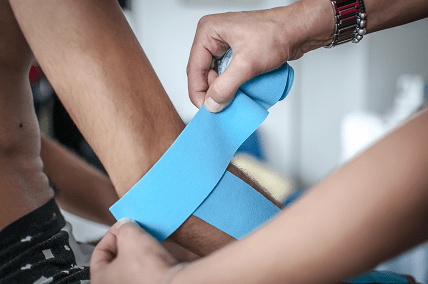Online Enquiry Form

Overview
The elbow is a very strong and stable joint, made up of 3 bones, 1 from the upper arm and 2 from the forearm. Elbow dislocation commonly refers to hyper-extension or over-straightening injury, forcing apart the bones back of the elbow. Injury may be classified as; a partial dislocation – called a subluxation a full dislocation – called a complete dislocation.
Children suffer more subluxation injuries while adults suffer more complete dislocation injuries, usually by fall injuries in sports or by bracing themselves in car accidents. The risk of blood vessel and nerve injury in elbow dislocation makes it an emergency condition made even more serious in cases of large dislocation or fracture dislocation of the elbow.
Symptoms
An elbow dislocation may exhibit the following symptoms:
- Extreme pain.
- Complete loss of function of the elbow.
- Disfigurement of the elbow.
- Strong muscle contraction and spasms of the elbow.
- Associated swelling and bruising.
- Associated pins and needles or numbness down the forearm into the hand.
- Extreme anxiety and worry.

Causes
An elbow dislocation may be caused by:
- Forced straightening of the elbow.
- An awkward twisting forearm against a straightening elbow.
- A combination of both.
Fall Injuries
A normal reaction to falling is to reach out to break your fall. If your arm locks at an unusual angle against the ground on impact, you may not be able to stop it from straightening beyond its means.
Car Accidents
Similar to a fall, reaching out to a dashboard or steering wheel on impact during a motor vehicle accident, may cause the force of the impact to overextend the elbow.
Diagnosis
To diagnose an elbow dislocation, the following will be taken into consideration:
- Understand the nature of the injury (sports, work, accident, overuse etc).
- Determine the cause of the injury (impact, collision, fall, repetitive/slow onset).
- Understand the context of the suffering (age, return to sport, work, impact on daily living).
- Perform a physical examination to ascertain pain and stability.
- Perform specialised shoulder tests to confirm diagnosis.
Partial Elbow Dislocations
The joint surfaces of the elbow may have partially separated and returned to their normal position. This type of injury causes pain, swelling and a feeling of instability of the elbow. Hypermobility tests can be used to determine if an elbow has been partially dislocated.
Complete Elbow Dislocations
Disfigurement of the elbow will be obvious in complete dislocation. You will not be unable to bend or twist your elbow. Your pulse and sensation should be checked at the wrist and& hand to determine if you have sustained a serious blood vessel or nerve injury. An xray and MRI will confirm any fractures and associated blood vessel or nerve damage. Early diagnosis and treatment are extremely important to avoid re-injury and serious long-term consequences.

Treatment
Treatment begins with a thorough diagnosis of your condition to understand the severity of the condition in the context of your age, your sport, your work and your life.
Non-Surgical Treatment
Non-surgical treatment of the injury requires:
- Emergency relocation.
- Rest and immobilisation for a least 6 weeks.
- Pain and anti-inflammatory medication.
- Elbow bracing.
- Consideration for surgery.
- Physiotherapy rehabilitation protocol.
Surgical Treatment
Generally, surgery is not necessary for elbow dislocation injuries. Elbow stability surgery is indicated in serious elbow dislocation injury involving additional elbow injuries such as fractures, blood vessels or nerve damage.
Dr Gupta will assess whether either of the following surgical treatments is necessary:
- Fracture reduction (ORIF).
- Nerve entrapment.
Fracture Reduction (ORIF): Open reduction internal fixation of the elbow requires Dr Gupta to locate the bony fragments of the fracture and, using a metal plate and screws, bind them together where they belong. The plate and screws will remain in the patient.
Nerve Entrapment: Cubital tunnel release is the technical name of the surgical procedure Dr Gupta will use to release pressure on the ulnar nerve which may become trapped at the elbow. This is a simple procedure with a very small incision used to identify and release the nerve.
Elbow dislocation injury causes separation of the humerus of the upper arm, from the ulnar of the forearm. Damage may occur to the joint capsule, blood vessels, nerves and possibly involve additional bony fracture.
The elbow is a robust joint and dislocation usually does not involve surgery. If surgery is required, it will only be necessary to repair secondary damage like bony fracture or blood vessel or nerve entrapment.

Post Operative Rehabilitation
You will achieve the best surgical outcome if you follow up surgery with a matching course of rehabilitation. Following surgery, Dr Gupta will outline the most appropriate rehabilitation protocol for your physiotherapist to follow and communicate with your healthcare team to ensure that you receive the best post-operative treatment.
Please contact our friendly team on 02 9687 8344 or make an online enquiry here.

Dr Manish Gupta | MBBS FRACS FAOrthoA
Dr Manish Gupta is a renowned expert surgeon in the field of orthopaedic surgery specialising in upper limb including shoulder, elbow and wrist.